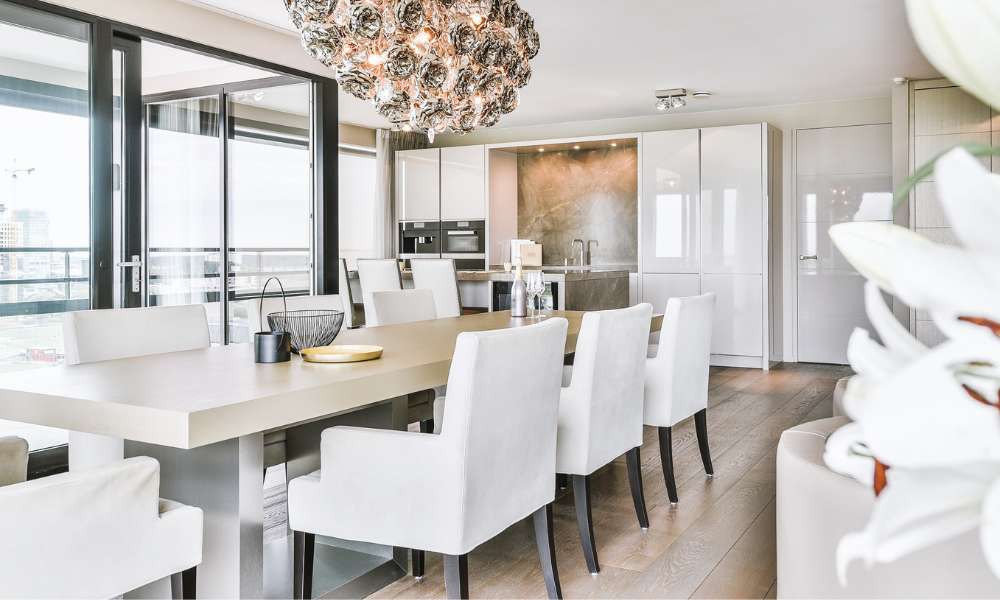Transforming your dining table with a fresh coat of paint can breathe new life into your dining space, offering a cost-effective way to refresh your home’s aesthetic. Whether you want to update an old table to match your new décor or simply love the idea of customizing your furniture, painting a dining table allows you to add a personal touch to one of the most important pieces of furniture in your home. In this guide, we will walk you through the process step-by-step, ensuring that you achieve a professional and durable finish. From selecting the right materials to applying the final protective coat, we’ve covered everything you need to know to paint your dining table successfully.
Materials and Tools Needed
List essential materials
- paint
- primer
- sandpaper
Recommended tools
- brushes
- rollers
- drop cloths
Safety gear
- gloves
- mask
- goggles
1. Preparing the Table
Preparing your dining table is a crucial step to ensure a flawless paint job. Start by thoroughly cleaning the table to remove any dirt, grime, and old polish. Use a mild detergent and water, making sure to wipe down every surface. Once the table is clean and dry, sanding becomes essential. Sanding not only smooths the surface but also helps the new paint adhere better. Begin with medium-grit sandpaper (around 120 grit) to remove any rough spots or old finish, then move to finer grit (around 220) for a smoother finish. Sand in the direction of the wood grain to avoid scratches. After sanding, it’s important to repair any dents, scratches, or damages using wood filler. Apply the filler, let it dry, and then sand the area until smooth. Proper preparation sets the foundation for a professional-looking and long-lasting painted dining table.
2. Choosing the Right Paint
Selecting the right paint for your dining table is crucial to achieving a durable and attractive finish. There are several types of paint suitable for this project, each with its own advantages and drawbacks. Latex paint is popular for its ease of use and quick drying time, making it ideal for beginners. However, it may not be as durable as other options. Oil-based paint, on the other hand, offers a hard, durable finish that can withstand heavy use but requires longer drying times and proper ventilation during application.
Chalk paint is another excellent choice, known for its matte finish and minimal prep work, though it typically needs a protective top coat for added durability. When it comes to color selection, consider the existing décor of your dining room and current trends. Neutral colors like white, gray, and beige are timeless, while bold hues like navy, emerald, and mustard can make a striking statement. Always choose high-quality paint to ensure a smooth, long-lasting finish that will enhance the beauty of your dining table for years to come.
3. Applying Primer
Priming the surface of your dining table is a crucial step that ensures the paint adheres properly and provides a smooth, even finish. Primers come in various types, including stain-blocking primers that prevent old stains from bleeding through the new paint and adhesion-promoting primers that help the paint stick to the surface. To apply the primer, start by stirring it well and pouring it into a paint tray. Use a high-quality brush or roller to apply a thin, even coat of primer to the entire table, working in the direction of the wood grain. Allow the primer to dry completely, which usually takes about 1-2 hours, depending on the product and environmental conditions. For the best results, apply a second coat of primer and let it dry thoroughly. Proper priming creates a solid foundation for your paint, ensuring a durable and professional-looking finish on your dining table.
4. Painting the Table
Achieving a smooth and even finish when painting your dining table requires careful technique. You can choose between brushing and rolling, with each method having its advantages. Brushing allows for precision, especially on intricate details, while rolling covers larger areas more quickly and evenly. For a professional look, consider using spray coloring, which provides a flawless, even coat with minimal effort.
To avoid common painting mistakes like streaks, drips, and uneven coverage, ensure you apply the paint in thin, even layers. Work in the direction of the wood grain and maintain a consistent speed. Allow each coat to dry completely before applying the next one, typically around 4-6 hours, depending on the paint type. Most projects will require at least two coats for full coverage and durability. By taking your time and following these techniques, you’ll ensure your dining desk looks professionally painted and stands up well to daily use.
5. Adding a Protective Finish
Sealing the paint on your dining table is essential for ensuring its durability and longevity. Applying a protective finish shields the paint from scratches, spills, and everyday wear and tear. There are several types of finishes to choose from, including polyurethane, wax, and varnish. Polyurethane is highly durable and available in both water-based and oil-based formulas, providing a clear, hard coat. Wax offers a softer, more natural finish but requires regular reapplication.
Varnish is another strong option, known for its robust protection and glossy sheen. To apply the finish, use a high-quality brush or a clean, lint-free cloth, working in the direction of the wood grain. Apply thin, even coats, allowing each layer to dry thoroughly before adding the next. Typically, two to three coats are recommended for optimal protection. By taking the time to seal your painted table properly, you ensure a beautiful and resilient finish that will keep your dining desk looking pristine for years to come.
6. Letting the Paint Cure
Allowing the paint to cure properly is crucial to achieving a durable and long-lasting finish on your dining table. While the paint may feel dry to the touch within a few hours, it typically requires a curing period of 24 to 48 hours before light use and up to 30 days for the paint to fully harden. During this time, avoid placing heavy objects on the table or using it for meals to prevent indentations and damage. To ensure the paint sets properly, maintain a dust-free environment and moderate temperature in the room where the table is located. If possible, keep the table in a well-ventilated area to expedite the curing process. Proper curing not only enhances the durability of the coloring but also ensures a smooth, professional finish that will last for years.
7. Final Touches and Maintenance
After the paint has cured, it’s time for the final touches and maintenance to ensure your dining table looks its best and lasts for years. If you disassembled the table for painting, carefully reassemble it, making sure all parts are securely in place. To maintain the painted surface, clean the table regularly with a soft, damp cloth and avoid harsh chemicals that could damage the finish. For tougher spots, use a mild soap solution. To address minor damages like scratches or chips, keep a small amount of leftover paint on hand for touch-ups. Lightly sand the affected area, apply the coloring, and let it dry completely. Regular maintenance and prompt attention to any damage will keep your painted dining desk looking fresh and vibrant.
Conclusion
Painting your dining table is a rewarding project that can transform the look of your space without the expense of buying new furniture. By following the steps outlined in this guide—preparing the table, choosing the right coloring, applying primer, painting, adding a protective finish, and allowing the paint to cure—you can achieve a professional-quality result. Remember to reassemble your table carefully and maintain it properly to enjoy its refreshed appearance for years to come. With a bit of effort and attention to detail, your newly painted dining desk will not only look beautiful but also serve as a testament to your DIY skills.





